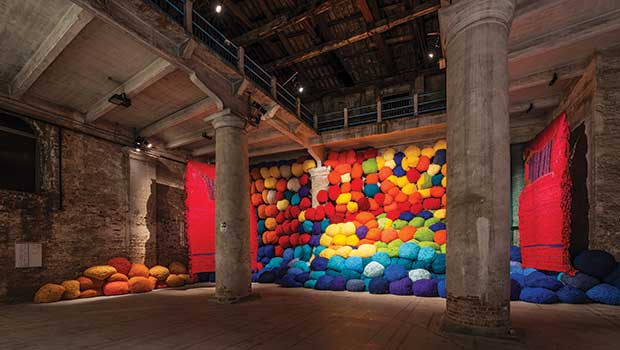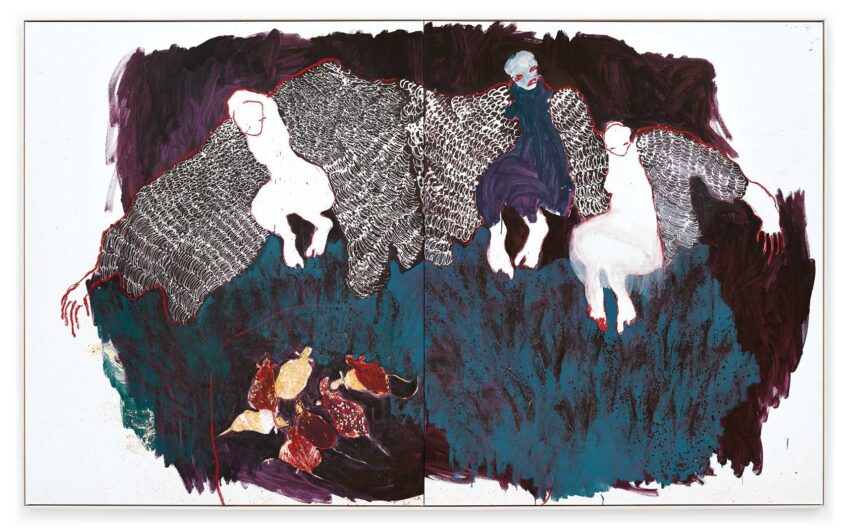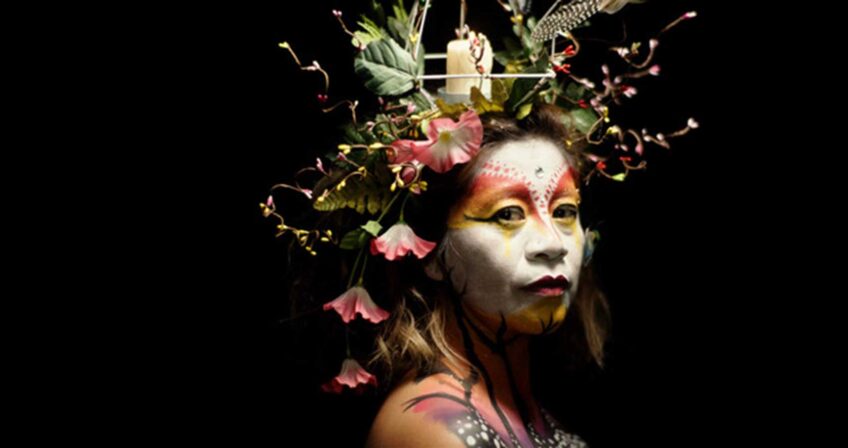
Utopias, dreams, losses, memories and hard truths all have a place in the carnival midway that is the Venice Biennale, which every two years for more than a century has turned its host city on the Adriatic into a showcase of both the state of contemporary art and the state of the world.
The 57th edition opened in May and remains on view until November 26, providing a sampling of spectacles from 86 countries and 120 artists, including 103 first-time participants. Some works occupy the permanent pavilions of 30 nations in the Giardini, a forested park along the Venetian Lagoon. Still more fill the cavernous Arsenale, where Venice built its ships during the 12th through 18th centuries, when it ruled the Mediterranean in trade and military might.

Author: Joshua White/Courtesy the artist and Hauser & WirthMark Bradford, “Tomorrow Is Another Day,” La Biennale di Venezia, US Pavilion, Venice, Italy, 2017.
On the Web
For more information about the Venice Biennale, visit: www.labiennale.or…
A big draw is the pavilion of Germany, which received the Golden Lion, the Biennale’s the top prize, for its portrayal of angst. Frankfurt-based artist Anne Imhof, 39, gutted the large structure, transforming it into a glass house with transparent walls and floors that offers visitors views of each other and, underfoot, a spare assortment of cast-off objects suggesting the left-behind possessions of young drifters, including a guitar, shell casings, eating utensils, clothing and a sleeping mat. At scheduled intervals, a cadre of young actors accompanied by Doberman Pinschers marches in unison and strikes sculpted poses, as if in an edgy fashion show.
More connected to the real world is the installation by Mark Bradford in the US pavilion, a structure modeled on Thomas Jefferson’s Virginia mansion, Monticello, complete with Doric columns. A MacArthur genius award recipient, Bradford turns the pavilion into a symbol of ruin, starting with its courtyard, which he filled with debris and a cement slab inscribed with a Greek poem about Hephaestus, the god of the forge. Hero of artists and outsiders, the god was cast off Mount Olympus for his singular flaw — a lame foot. As visitors enter the first of five galleries, they squeeze around a massive, blotchy structure entitled “Spoiled Foot.” The pavilion’s elegant rotunda is now a raw grotto, coated with black and gold coils of bleached paper.
Black and gay, Bradford often addresses intolerance and injustice in his semi-abstract works, many composed of end papers used by his late mother, the owner of a beauty salon, to straighten her clients’ hair. Her salon is now part of his studio in South Los Angeles, where he runs a project engaging vulnerable youth in art projects. In Venice, Bradford has developed and funded a six-year program that trains and employs inmates in two local prisons to produce luxury accessories, preparing them for life after release.
Imagined past
An outsider’s perspective is also rendered in the Australia pavilion, where Tracey Moffatt, an artist of mixed-race heritage, creates suggestive dramas evoking the Aborigine experience. In her series of large-format photographs entitled “My Horizon,” she portrays herself wearing mourning earrings and attired in a maid’s uniform, honoring the livelihood of her mother and grandmother, as she visits barren landscapes. Her haunting video, “The White Ghosts Sailed In,” simulates a grainy reproduction of a video showing the headlands of Sidney Harbor, where in the 18th century, ships carrying convicts expelled from England first entered the country, setting in motion a migration of European settlers that claimed Aborigine lands.
Vancouver-based Geoffrey Farmer turns Canada’s pavilion into an installation that intertwines stories of his family with the history of Canada, which this year celebrates its 150th anniversary. Entitled “A way out of the mirror,” the ensemble of water works and evocative objects evokes personal losses as well as Canada’s epic narrative, including construction of its transcontinental railroad. Farmer exploits the site, currently roofless as it undergoes renovation, and its leafy view of the Venetian basin and incoming ships, as a setting for lyrical water sculptures and objects laden with personal and national meaning — including a vintage clock from Vancouver, a hammer, tools and, carved into a weeping stone, lines from a poem by Alan Ginsberg mourning the death of his mother, “Kaddish.” Waterworks spout, spray, and leap and the centerpiece, a geyser, shoots skyward and falls in a grand cascade.
Northern perspective
Looming over a corner of the South Korea pavilion is Cody Choi’s satirical neon fantasia, “Venetian Rhapsody,” complete with an Asian tiger and blinking disco lights. Inside the pavilion is a poignant installation by another young Korean artist, Lee Wan, who evokes the life of a fictional Korean everyman, Mr. K, through a meticulous display of the man’s possessions and photographs spanning decades of dictatorship, war and economic rebirth.
Finland’s unassuming, tent-like pavilion, designed by renowned Finnish architect Alvar Aalto, is a viewing gallery for a bracingly funny show entitled “The Aalto Natives.” Surrounding the audience with four videos and giant, muppet-like puppets, this production by UK-born Nathaniel Mellors and Finn Erkka Nissinen satirizes Finland’s resilient social democracy and such quirks as its love of herring, as well as broader preoccupations such as the origin of life and the meaning of human existence.
Grand production
As Egypt endures a failed revolution and the return of violent political repression, artist Moataz Nasr gives voice to his country’s abiding desire for a better future through a video folk tale performed by a cast of more than 100 actors and citizens. Entering Egypt’s modernist pavilion, visitors step into a rural setting, with straw and sand underfoot and a wooden railing encircling the seats. Projected on five screens in a 135-degree arc that simulates an expansive mountain landscape, his gorgeous 12-minute film, “The Mountain,” tells the story of a young girl who challenges her village’s fear of going outside after sunset, a superstition that has turned them into prisoners within their own homes.
Individuals
Some pavilions highlight individual artists. Romania devotes its galleries to an enchanting retrospective of venerated artist Geta Bratescu, 91. Featuring works on paper, videos, and photographs spanning six decades, the show includes this pioneering artist’s surrealistic drawings, illustrations of fairy tales, and multimedia experiments — many infused with her searching female perspective. Among the highlights is a self-portrait, “Lady Oliver in Traveling Costume” (1980-2012), in which she photographs herself embracing her mother’s Oliver typewriter as if it were part of her.
In the vast chambers of the Arsenale, a quietly compelling series of small prints depicting a whale unit by Inuit artist Kananginak Pootoogook (1935-2010), holds its own. A monumental stack of colorful yarn globes by Nebraska-born Sheila Hicks, 83 (“Escalade Beyond Chromatic Lands,” 2016–17) fills a 50’ wall. In the Italian Pavilion, a trio of artists turns an entire wing of the Arsenale into a brooding exploration of the occult. Entitled “Il Mondo Magico,” their works include a mirrored ceiling that reflects an enormous pool of water and corpse-like figures undergoing alchemical transformation, defying death.






